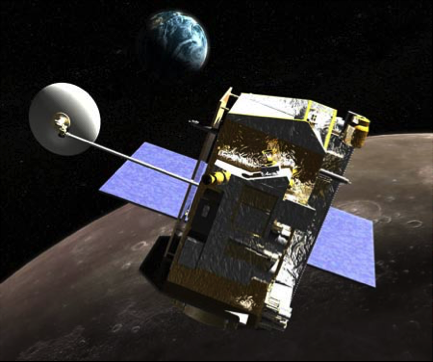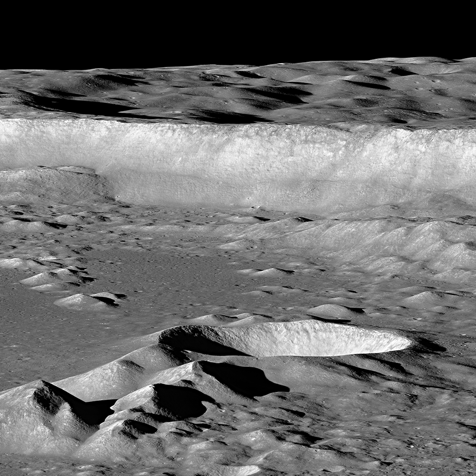Johnson Space Center to host Lunar Reconnaissance Orbiter science meeting
2017-02-06
NASA’s Astromaterials Research and Exploration Science Division will host planetary scientists and lunar experts from the Lunar Reconnaissance Orbiter (LRO) mission Feb. 7 to 8 at Johnson Space Center — the agency’s lead center for fundamental lunar science.
Spacecraft operators and scientists will convene in Houston to decide how to operate the LRO, a NASA spacecraft that has been in lunar orbit since 2009, in order to achieve the science goals of its upcoming Cornestone Mission designed to collect critical new data from the moon.
“NASA’s Johnson Space Center is the heart of America’s space program,” said Samuel Lawrence, Ph.D., an expert in lunar geology, planetary cartography and advanced exploration planning with the Astromaterials Research and Exploration Science Division at Johnson, who has been part of the LRO team since 2007. “The LRO was originally conceived of as a precursor mission for human exploration and is producing phenomenal science. As NASA proceeds with ambitious human exploration efforts beyond low-Earth orbit, the way that the LRO integrates science and exploration is a worthy model to emulate.”
LRO is a NASA Science Mission Directorate mission operated under the umbrella of the Discovery Program and managed by the Goddard Space Flight Center.
According to Lawrence, LRO was recently approved for a mission extension in late 2016, the Cornerstone Mission. As the name suggests, exploration of the moon has been largely credited as the “cornerstone” of planetary science.
“The LRO Cornerstone Mission is designed to collect critical new data from the moon to help us understand fundamental solar system natural processes, such as the impact cratering process, to produce the data needed to understand Mars and other objects in the solar system,” Lawrence said. “The goal of the meeting at Johnson is to hammer out the specifics of LRO’s science campaigns to meet the ambitious goals of the Cornerstone Mission.”
The LRO is equipped with a suite of instruments to study the lunar surface. It has a camera for ultra-high resolution photographs; an infrared radiometer to gather information on thermal properties and composition; a neutron detector that can determine the abundance of hydrogen; a far-ultraviolet imaging spectrograph that can peer into the darkest craters; a laser altimeter, which can measure the topography of the moon at the meter scale; a cosmic ray telescope to characterize the lunar radiation environment; and a radar to assess the properties of the lunar resource deposits.
Lawrence indicated that the LRO has returned more data than any other planetary mission to date, with more data being collected every day.
“Results from LRO have completely redefined our scientific understanding of the moon,” Lawrence said. “Some of these discoveries include that the moon might still be volcanically active; that impact craters are still forming on the moon; and that there are potentially vast deposits of untapped, yet accessible, resources on the moon that could be used to enhance human exploration capabilities.”
Tracy Calhoun, manager of the Astromaterials Exploration Science Office at Johnson, looks forward to the meeting as a chance to collaborate and mesh the worlds of science and engineering, as “our robotics affiliation helps embolden human space exploration.”
The Astromaterials Research and Exploration Science Division at Johnson is charged with preserving NASA’s collection of extraterrestrial samples, keeping them safe and providing them to the global scientific community for research. The collection includes samples from the moon, Mars, sun, asteroids, comets and other stars. Samples from the OSIRIS-REx mission to the asteroid Bennu and the Japanese Space Agency’s Hayabusa 2 mission will be added to the collection in the coming years.
For more information on the LRO mission, go to: https://lunar.gsfc.nasa.gov/
For more information on Astromaterials, go to: www.nasa.gov/centers/johnson/astromaterials
Follow the mission on Twitter: twitter.com/LRO_NASA
Follow Astromaterials on social media at:
Facebook: facebook.com/NASAastromaterials
Twitter: twitter.com/Astromaterials
Instagram: instagram.com/NASAastromaterials
Spacecraft operators and scientists will convene in Houston to decide how to operate the LRO, a NASA spacecraft that has been in lunar orbit since 2009, in order to achieve the science goals of its upcoming Cornestone Mission designed to collect critical new data from the moon.
“NASA’s Johnson Space Center is the heart of America’s space program,” said Samuel Lawrence, Ph.D., an expert in lunar geology, planetary cartography and advanced exploration planning with the Astromaterials Research and Exploration Science Division at Johnson, who has been part of the LRO team since 2007. “The LRO was originally conceived of as a precursor mission for human exploration and is producing phenomenal science. As NASA proceeds with ambitious human exploration efforts beyond low-Earth orbit, the way that the LRO integrates science and exploration is a worthy model to emulate.”
LRO is a NASA Science Mission Directorate mission operated under the umbrella of the Discovery Program and managed by the Goddard Space Flight Center.
According to Lawrence, LRO was recently approved for a mission extension in late 2016, the Cornerstone Mission. As the name suggests, exploration of the moon has been largely credited as the “cornerstone” of planetary science.
“The LRO Cornerstone Mission is designed to collect critical new data from the moon to help us understand fundamental solar system natural processes, such as the impact cratering process, to produce the data needed to understand Mars and other objects in the solar system,” Lawrence said. “The goal of the meeting at Johnson is to hammer out the specifics of LRO’s science campaigns to meet the ambitious goals of the Cornerstone Mission.”
The LRO is equipped with a suite of instruments to study the lunar surface. It has a camera for ultra-high resolution photographs; an infrared radiometer to gather information on thermal properties and composition; a neutron detector that can determine the abundance of hydrogen; a far-ultraviolet imaging spectrograph that can peer into the darkest craters; a laser altimeter, which can measure the topography of the moon at the meter scale; a cosmic ray telescope to characterize the lunar radiation environment; and a radar to assess the properties of the lunar resource deposits.
Lawrence indicated that the LRO has returned more data than any other planetary mission to date, with more data being collected every day.
“Results from LRO have completely redefined our scientific understanding of the moon,” Lawrence said. “Some of these discoveries include that the moon might still be volcanically active; that impact craters are still forming on the moon; and that there are potentially vast deposits of untapped, yet accessible, resources on the moon that could be used to enhance human exploration capabilities.”
Tracy Calhoun, manager of the Astromaterials Exploration Science Office at Johnson, looks forward to the meeting as a chance to collaborate and mesh the worlds of science and engineering, as “our robotics affiliation helps embolden human space exploration.”
The Astromaterials Research and Exploration Science Division at Johnson is charged with preserving NASA’s collection of extraterrestrial samples, keeping them safe and providing them to the global scientific community for research. The collection includes samples from the moon, Mars, sun, asteroids, comets and other stars. Samples from the OSIRIS-REx mission to the asteroid Bennu and the Japanese Space Agency’s Hayabusa 2 mission will be added to the collection in the coming years.
For more information on the LRO mission, go to: https://lunar.gsfc.nasa.gov/
For more information on Astromaterials, go to: www.nasa.gov/centers/johnson/astromaterials
Follow the mission on Twitter: twitter.com/LRO_NASA
Follow Astromaterials on social media at:
Facebook: facebook.com/NASAastromaterials
Twitter: twitter.com/Astromaterials
Instagram: instagram.com/NASAastromaterials









